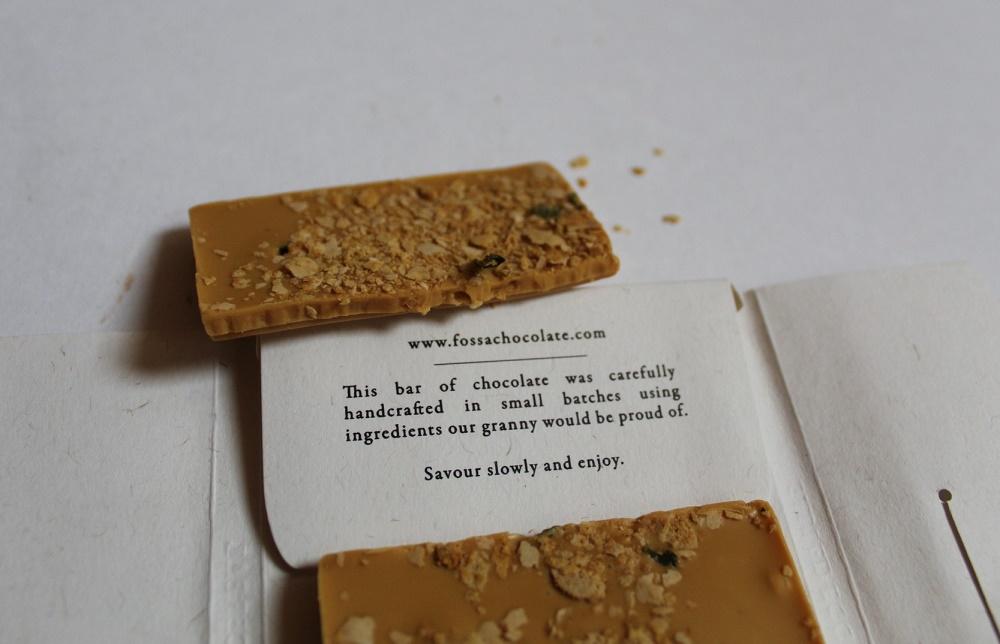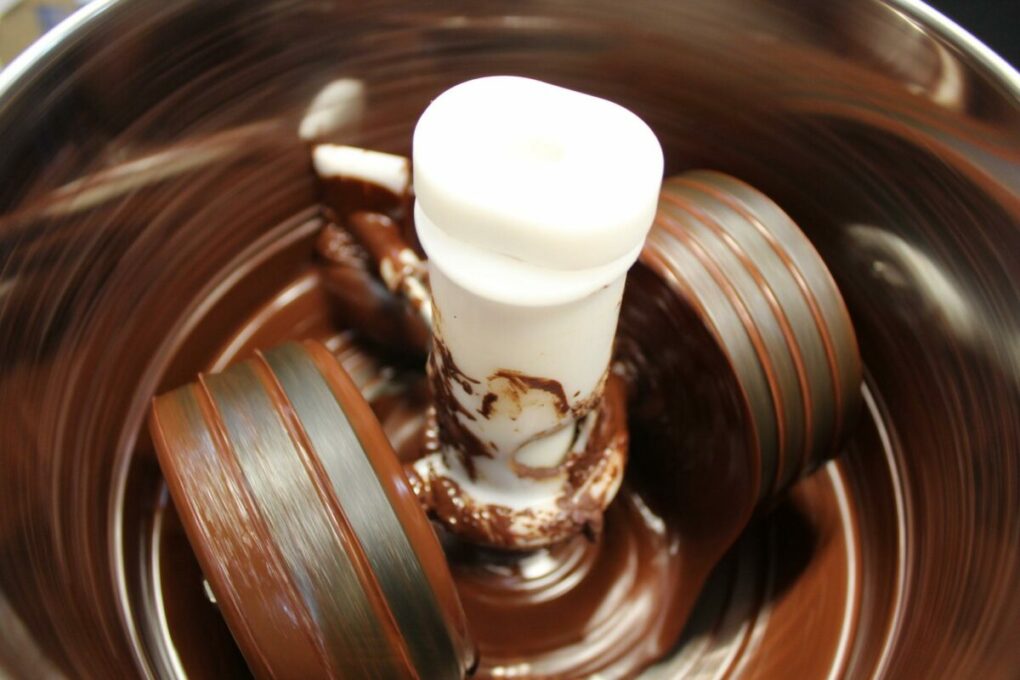Salt is usually used to finish off a dish by sprinkling some on top. It goes great on grilled meats, roasted vegetables, cakes, and pastries— as well as on chocolate. This sweet and salty combination of chocolate and salt is not new. Ancient Mesoamerican civilizations were known to add flavorings to their cocoa beverages.

Salt has remained an important resource for civilizations since pre-Hispanic rule. Both cocoa and salt have a history of being used for monetary purposes; the word 'salt' is even the linguistic basis for your annual salary. So it’s entirely possible that salt was one of those ancient flavorings. However, the commercialization of salt and chocolate as a combination is considered a relatively new trend.
In 1980 a French chocolatier, Henri Le Roux, created salted butter caramel. An interview states that one of the first mentions of salting chocolate came from the 1990s, when Pierre Hermé sprinkled chocolate with fleur de sel. From there, the trend has picked up particularly since the early 2000s.
But what makes salted chocolate so special? In the following section, we’ll look at salt’s unique quality to balance tastes, how it interacts with our bodies, and what benefits it can add to chocolate.

Jump To
What Makes Sea Salt So Special?
Normal table salt and sea salt actually have the same basic nutritional value and contain a comparable amount of sodium by weight. The main differences between the two are found in their taste, texture, and processing. The white iodized table salt found in most salt shakers is mined from underground deposits and processed to remove all other minerals.
On the other hand, sea salt is acquired through the evaporation of brine from seawater or saltwater lakes. In the US, some salts that did not recently come from the sea are able to be referred to as ‘sea salt’ as long as they meet FDA composition requirements.
Sea salt is overall less processed than table salt and retains trace minerals that give it additional flavor and color. These variations come from the local clays and algae found in the waters the salt is harvested from. For example, boutique salts from Korea and France are pinkish grey, whereas those from India and Hawaii are black or red. Sea salt also contains just a small amount of iodine compared to table salt, which is generally fortified with it.

What Does Sea Salt Do to Chocolate?
The effect of adding salt to chocolate will depend on the amount of cocoa, sugar, and sweeteners the chocolate contains. Salt is a flavor enhancer, and helps subdue the bitterness of chocolate and highlight sweet notes. There are 5 flavor elements: sweet, salty, sour, bitter, and savory. When balancing flavors, saltiness is known to cut down on bitterness and enhance other flavors, particularly sweetness.
Salt acts as a directly contrasting taste to sweetness, helping bring attention to the more complex flavors in chocolate. Beyond a contrast of elements, the way salt is perceived by our taste buds contributes to this complimentary effect. Sodium ions bond to salt receptors on our tongue, inhibiting our ability to perceive bitterness while increasing sensitivity to the other flavor elements. They call this "cross-modal perception."
Sodium also triggers a glucose sensor in the intestines, known as SGLT1, increasing its sensitivity to the sensation of sweetness. In this way, a single interaction with sodium smoothes out chocolate’s bitterness while highlighting and enhancing sweet notes & other flavors.
Much like other chocolate inclusions, salt is not soluble in fats like cocoa butter, and there isn’t enough moisture in chocolate to dissolve it. Because of this, when sea salt is mixed into chocolate, the large crystals remain suspended and add a grainy crunchy element to its texture. Balance is key here. Too little and there may not be enough to get the benefits, but too much and the chocolate may become too salty to be enjoyed.
Does Chocolate Milk Taste Better with Salt?
Chocolate milk was a staple in many people’s childhoods, but most of us didn’t grow up adding a pinch of salt to chocolate milk. And these days there are non-dairy options to complicate the mix. But regardless of type, the addition of milk masks the bitterness and heft of cocoa solids.
Ready-made options have been way ahead of the curb, however, they usually contain added sugars and a tiny amount of salt to act as a preservative. Copycat yoohoo and the like can be made at home by blending milk, cocoa powder, or chocolate syrup, and a sweetener. But adding just a bit of salt to your blend will have the same effect of enhancing its sweet flavor and subduing excess bitterness that may come from the cocoa.
In this recipe, a generous pinch of kosher salt was enough for 4 drinks, while this other recipe indicates that ¼ teaspoon yields 8. Hot chocolate tends to be more bitter, as it contains fewer sweeteners and has a higher cocoa content, but about ⅛ teaspoon of salt per cup will be enough to cut down its bitter taste.

Sea Salt Chocolate Benefits
Many studies have compared chocolate milk to popular workout recovery drinks. This is because salt chocolate milk contains a decent amount of calories, carbohydrates, vitamins, and nutrients, including post-workout protein. This synergy is thanks to dark chocolate's naturally high levels of the electrolytes potassium, magnesium, and calcium.
Adding salt to hot cocoa or chocolate milk includes sodium and chloride in the mix, rounding out the electrolytes needed to recover from a workout. Sea salt's effect of inhibiting the taste of bitterness is great when paired with chocolate of a high cocoa percentage. Chocolate with high cocoa content usually means less room for sugar and vegetable oils, the excessive consumption of which is not great for your health.
However, more cocoa content increases overall bitterness, and salt can help balance it out. The cocoa solids and cocoa butter in authentic chocolate also has subtle layers of flavor that sea salt can help express. Thanks to sodium's ability to trigger our sweet taste sensors, both the sweet and the fruity flavors are made more apparent.

Chocolate Salt FAQ
Salt smoothens the bitterness of cocoa while enhancing the other flavors of chocolate, particularly its sweetness.
Sea salt augments the already electrolyte-rich chocolate with sodium and chloride, creating a complete replenishing of your body’s electrolytes post-workout.
Sea salt can be put in melted chocolate, but it will not dissolve in it. Unless it's dissolved in a cream or syrup, the salt will instead add a grainy crunchy texture to the chocolate.
Sea salt in chocolate milk both enhances the chocolate flavor and the sweetness of the beverage.
Hot chocolate tends to contain more cocoa and is therefore less sweet. To balance this out, a pinch of sea salt is usually enough, at about double what you'd put in chocolate milk. However it is also up to taste, and the key is to strike a balance that doesn’t overpower the chocolate flavor.


















LJ
I completely disagree that for all people that sea salt enhances the flavor of chocolate or brings out the sweetness. I've heard countless chefs say this, but it doesn't do that for everyone. When I taste salt added to chocolate or chocolate milk, what I taste is salt. And then I wonder, "Why would someone want to make something that normally tastes sweet taste salty?" I can't stand it. There are so many brands of chocolate milk that I now consider ruined by the addition of salt. Who would have imagined a few decades ago that this would be a trend? I also don't like salted caramel. If I want to eat sweet caramel, then let me eat sweet caramel. I don't want salty caramel. If I want salt, I'll find something salty like many cheeses or chips or fries, etc... I wish this trend of adding salt to sweet things and acting like it improves them would end. For those of us who have a strong sweet tooth, please stop ruining our sweet treats with salt. They aren't improved, only made salty. Yuck.
Max
That is a lot of feelings about salt, LJ. Thankfully the vast majority of chocolates still do NOT contain any salt, so it's not hard to avoid.